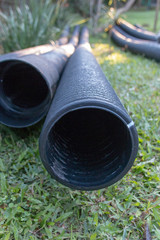French Drain Baltimore is an integral part of a property’s drainage system. When installed properly it will prevent flooded basements, foundation damage, and mud-covered lawns.
Water always seeks the lowest point and moves into empty pockets of loose soil. A French drain creates a hollow channel that directs excess water away from the property.
A French Drain is a trench lined with a water-permeable fabric that carries water from problem areas on your property. The drain collects groundwater and surface runoff, diverting it on a downward slope away from the house to a municipal storm drain or a garden area.
In order to select the best pipe material, you need to determine the volume of runoff your French Drain needs to manage. You can do this by calculating your catchment area by multiplying your yard’s length and width. Once you know your catchment area, use this information to estimate the amount of water the drain will need to manage each hour. Once you have this number, you can choose the appropriate diameter and layout of your drain.
Rigid PVC pipe is preferred for French Drains as it’s durable, economical and clogs less easily than flexible drain pipe. It’s also possible to use a snake on rigid PVC pipe, while a snake will ruin flexible drain pipe. For maximum efficiency, a french drain should be filled with gravel that’s larger than pea gravel. This will help the pipe function properly, without blocking its inlet holes. For the best results, choose washed angular gravel with a size of 20mm to 40mm.
When constructing your drain, make sure to always lay the perforated pipe with its holes facing down. This prevents sand and other fines from clogging the drain’s inlet, and will promote proper flow through the aggregate. Another important step is to line the drain trench with a non-woven drainage fabric. This will keep soil from mingling with the rock fill and prevent debris from clogging the French Drain.
CIS carries several different styles of drainage fabric, including heavyweight and lightweight options. Lightweight fabrics are more cost-effective than heavier ones, but they still provide good flow through rates. Heavyweight fabrics, such as rip rap, are typically used in erosion control applications and should not be utilized in French Drains.
Once the drain has been constructed, it’s time to add some gravel and top it off with your native soil. When adding the gravel, be sure to grade it so that it doesn’t block the drainage pipe. Ideally, the gravel should cover only about half of the drain so that the soil can properly retain water.
Perforated Pipe
Unless your home is built on a hill, it’s likely that rain and snow melt will pool in low spots around your property. In addition to causing unsightly puddles, standing water can also lead to mosquito breeding and moisture infiltration that damages foundations and other structures in your home. With a French Drain, you can take advantage of science to quickly and efficiently drain excess water away from your home.
To accomplish this, the French Drain uses a hollow, perforated pipe that’s buried under several layers of gravel. The perforations in the pipe allow water to enter and leave the pipe as it travels downhill, carrying water away from your home.
The pipe used in a French Drain can be made of various materials, including concrete, clay, or iron. The most common choice is PVC pipe, which offers a number of advantages over other materials. PVC pipe is flexible, durable, and easy to install. In addition, it’s less expensive than concrete and iron pipe. When choosing a pipe for your French Drain, it’s important to consider the pipe’s diameter and whether or not it is slotted or perforated. The larger the pipe’s diameter, the more water it can carry. A 4-inch diameter pipe is typically adequate for most residential drainage needs.
Once you’ve chosen a pipe, you’ll need to dig a trench that reaches just below the level of the problem area. You’ll then fill the trench with gravel until it’s about a foot above the surface of the ground.
Next, you’ll place the perforated pipe into the trench. It’s important to note that the holes in a perforated pipe need to be facing down. If the holes are facing up, the water can clog them and cause problems down the line.
Some people choose to wrap a sock or piece of fabric around their pipe after it’s been placed in the trench. While this may offer some added protection from clogs, we don’t recommend it. Instead, make sure you use a quality landscape fabric that allows water to pass through while preventing weeds, dirt, and debris from clogging the pipe.
Gravel
The gravel used in a French Drain is essential to its overall success. This material enables water to travel through it more efficiently than soil, preventing blockages and keeping the system working as it should. It also adds a desirable aesthetic element to the landscape, helping to conceal the drain while providing a natural look to your property.
The type of gravel used in your French Drain will depend on a few factors, including the intended purpose and volume of water the drain is expected to handle. Hard rocks, such as granite or river gravel, are viable options because they won’t break down over time and are more resistant to corrosion from the pipe. Pea gravel is another option, as it’s easy to maintain and blends well with various landscaping styles.
When determining the amount of gravel needed for your French Drain, start by measuring the area that needs to be covered. Once you have the measurements, you can then use a gravel calculator to determine the total amount of gravel needed for the entire drain installation. This will ensure that you have enough gravel to cover the desired area, but not so much that it is overly dense or clumps together.
Once you’ve determined the amount of gravel necessary for your project, you can begin digging your drain. Dig a trench that is the same length as the desired drain area, then line it with filter fabric and 3 inches of gravel. Place the 4″ perforated corrugated pipe on top of the gravel, then fill in the remaining space with additional gravel to cover the pipe and prevent soil from washing into and clogging the drain.
Before you finish constructing your French Drain, it’s important to inspect the finished product to ensure that water is flowing as it should. Check for any clogs or signs of sludge in the drain and make adjustments as necessary. Ultimately, your French Drain should be able to effectively divert water away from your home without damaging the surrounding landscape.
Once your French Drain is in place, you can enjoy the benefits it offers for years to come! In addition to preventing damage from moisture, a properly functioning drainage system can help improve your home’s energy efficiency by reducing the need for indoor heating and cooling.
Filter Fabric
Whether you’re dealing with heavy erosion or a more minor issue, your French Drain will benefit from the addition of filter fabric. Using this non-woven geotextile will help prevent sediment from washing into the drainage pipe and clogging it over time. It’s a great way to extend the life of your drain and keep dirt from clogging up the gravel underneath.
Filter fabrics come in a variety of styles, each with its own unique capabilities of stabilization, separation, and drainage. They’re typically made of natural or synthetic materials. A common option is coir, which uses fibers extracted from the husk of a coconut shell to provide excellent erosion control. This material is strong, bacteria- and fungus-resistant, and eco-friendly. It’s also available in a number of thicknesses, providing you with options for every project.
The fabric you choose will depend on the type of sediment you’re dealing with, and how much water flow is required. Woven netting is ideal for fine sediments, while non-woven mats are better if you’re looking for something that can handle high water flow and has a large flow-through rate. If you’re installing a drain for a home, commercial property, or agricultural land, it’s important to talk to an expert who can help you determine which type of fabric is best for your needs.
When you dig your trench, make sure to leave 10-inches or 25.4 cm of fabric on either side of the pipe. This is necessary so you can wrap the fabric around the pipe once you’re finished and prevent any sediment from washing into the drain. The excess fabric can be trimmed back later, or you can use nails or pins to hold it in place temporarily.
A good professional-grade French Drain is a great way to deal with low “ponding” spots in your garden or yard. However, the drainage system won’t work as well unless you use the right materials. Avoid cheap, economy-grade drains sold at big box stores and online retailers, as they’ll decompose more quickly and may clog over time.
